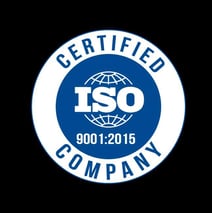Moving From ISO 9001:2008 To ISO 9001:2015 – What You Need To Know
by Cubbison, on Jul 24, 2018 11:59:00 AM
 September 15, 2018 represents a significant shift in how organizations ensure their products and services match customer expectations. This is the day the ISO 9001:2008 standard will become obsolete. But, this shouldn’t come as a surprise to the more than one million companies certified globally (Cubbison is ISO 9001:2015 certified). Three years prior, the International Organization for Standardization (ISO) published ISO 9001:2015, allowing organizations the opportunity to transition to the new standard within the set timeframe.
September 15, 2018 represents a significant shift in how organizations ensure their products and services match customer expectations. This is the day the ISO 9001:2008 standard will become obsolete. But, this shouldn’t come as a surprise to the more than one million companies certified globally (Cubbison is ISO 9001:2015 certified). Three years prior, the International Organization for Standardization (ISO) published ISO 9001:2015, allowing organizations the opportunity to transition to the new standard within the set timeframe.
What is ISO 9001:2015?
ISO 9001 is the international standard that addresses various aspects of quality management and provides companies with guidance to ensure products and services meet customer and regulatory requirements while also demonstrating quality is consistently improved. ISO 9001:2015 can be used by any organization and sets out the criteria for a quality management system. This includes a strong customer focus, the motivation and implication of top management, process approach and continual improvement.
What’s the difference between ISO 9001:2008 and ISO 9001:2015?
First and foremost, the number of clauses has increased from eight to ten with content adjusted to better align with other standards.
| Section | ISO 9001:2008 | ISO 9001:2015 |
| Section 0 | Introduction | Introduction |
| Section 1 | Scope | Scope |
| Section 2 | Normative reference | Normative reference |
| Section 3 | Terms and definitions | Terms and definitions |
| Section 4 | Quality management system | Context of the organization |
| Section 5 | Management responsibility | Leadership |
| Section 6 | Resource management | Planning |
| Section 7 | Product realization | Support |
| Section 8 | Measurement | Operation |
| Section 9 | Performance evaluation | |
| Section 10 | Improvement |
The first three standards remain unchanged between ISO 9001:2008 and ISO 9001:2015. However, sections 4-10 are now arranged according to the Plan-Do-Check-Act (PDCA) Cycle. This cycle is a four-step management method used to achieve and maintain control and continual improvement of products and processes. For example, Section 4 – Context of the organization means an organization must determine, monitor and review both internal and external issues as well as relevant interested parties and their requirements. By following the PDCA cycle, customers can rest easy knowing they are receiving consistent, good quality products and services, which in return bring many business benefits.
Terminology
The new standard has simplified some concepts. The terms “Documents,” “Procedures,” and “Records” all have been eliminated. They’ve been replaced with “Documented Information.” The goal of this is to be open to a greater understanding and acceptance of alternative methods of controlling a quality management system.
Introduction of Risk-Based Thinking
One of the key changes to ISO 9001:2015 is the establishment of a systemic approach to risk, rather than treating it as a single component of a quality management system. ISO 9001 had previously addressed an issue through “preventative actions.” However, ISO 9001:2015 replaced the term with “actions to address risks and opportunities.”
Common methods for identifying and addressing risk include maintaining a risk register, performing FMEA (Failure Mode Effects Analysis) or HACCP (Hazard Analysis and Critical Control Points) techniques and utilizing a Probability and Impact Matrix. To emphasize the importance of ‘risk,’ the term is identified 48 times in ISO 9001:2015 as compared to only three times mentioned in ISO 9001:2008.
More Focus on Input & Output
There’s much more emphasis in ISO 9001:2015 on measuring and properly assessing both outputs and objects of processes. Objects can be material, immaterial or imagined such as the product produced or the service provided.
 Leadership in ISO 9001:2015
Leadership in ISO 9001:2015
The bar has been raised for top management. Previously, ISO 9001 determined leadership would be responsible to handle communication of the quality management system and manage employees. Now, ISO 9001:2015 requires management to be more engaged in the overall management and functioning of the quality management system. This includes being accountable, ensuring resources are identified and available, making sure the quality management system is aligned with business processes along with other criteria. ISO 9001:2015 is intended to encourage integration and harmonization with business processes and strategies.
We at Cubbison are proud to be recognized as one of the few companies to achieve this level of certification to date. To us, our ISO 9001:2015 registration is verification of our ingenuity, leadership, progressiveness, and our attention to detail, efficiency, quality, safety and care for our customers in the printed electronics and product identification industries.




